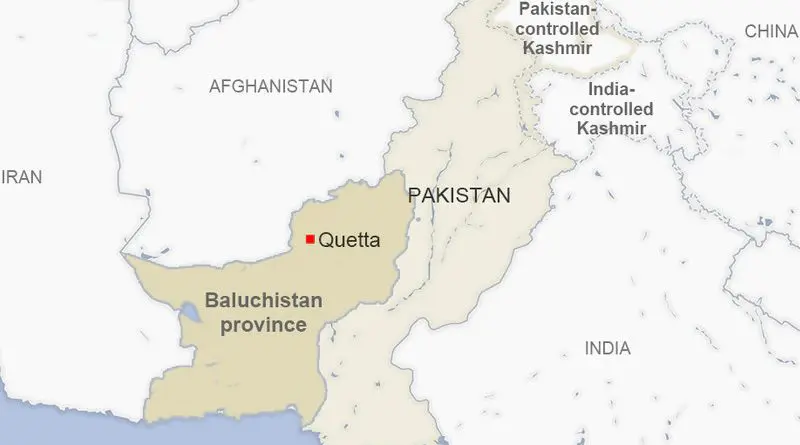BLA Insurgency In Balochistan Region – OpEd
On Tuesday, the Balochistan Liberation Army (BLA) claimed responsibility for attacking and seized the Jaffer Express train in southwestern Pakistan, taking hundreds of passengers’ hostage during its 1,600km journey from Quetta to Peshawar, Khyber-Pakhtunkhwa (KPK) province.
Director General ISPR Lt-Gen Ahmed Sharif Chaudhry announced the “successful completion” of a clearance operation following the Jaffar Express hijacking in Balochistan’s Bolan Pass, resulting in the safe rescue of passengers and the elimination of all 33 terrorists involved.
The Balochistan Liberation Army (BLA) consistently targets Pakistani security forces and civilians, including Chinese nationals linked to the China-Pakistan Economic Corridor (CPEC). Despite government assertions of reduced violence, attacks continue in Balochistan, with Islamic militant groups also active in the region.
Emergence and Reasons behind BLA?
The Balochistan Liberation Army (BLA) was initially formed in 1964 with Soviet support and communist leadership. It was later revived in 2000 by Nawab Balach Marri, with continued Marxist ideologies and has evolved through the leadership of the Marri family.
In 2010, BLA commander Aslam Baloch formed the Majeed Brigade, a suicide bomber unit named after two slain brothers, Majeed Langos. This unit introduced effective terror tactics, recruiting Baloch militants from various organizations. Inspired by Marxist and Maoist teachings, the Majeed Brigade targets, ironically, include Chinese interests.
The Balochistan Liberation Army (BLA) has become more audacious since the Pakistani Taliban ended their ceasefire with the government in November 2022, spurring increased militant attacks nationwide. The situation in Balochistan is multifaceted and deeply entrenched, with numerous factors contributing to the escalating violence in the region.
Since Pakistan’s inception in 1947, Balochistan has experienced at least five separatist uprisings. The most recent wave commenced in the early 2000s, initially aimed at obtaining a greater share of the province’s resources for its inhabitants, but it quickly evolved into demands for complete independence.
With growing resentment towards the state, the BLA emerged in the late 1990s and early 2000s. Analysts studying Baloch resistance movements say it was led by Balach Marri, son of veteran Baloch nationalist leader Nawab Khair Bakhsh Marri.
In 2017, the Baloch Liberation Army faced internal conflicts, leading to leadership shifting from the Sardar family to Aslam Baloch. This resulted in two BLA factions: one led by Aslam Baloch (now Bashir Zeb) and the other loyal to Harbyar Marri.
Sources of BLA’s Operational Funding?
BLA’s funding sources are multiple revenue streams, including illicit activities such as extortion, smuggling, drug trafficking and India’s funding which is main reason of behind this.
India’s funding in Balochistan province is a main economic source for the group although india is already exposed when on 3 March 2016, Jadhav was arrested inside Balochistan in Mashkel near the border region of Chaman. He is accused of carrying out espionage and sabotage activities against Pakistan at the behest of India’s intelligence agency.
Their training takes place in Iran, Afghanistan and certain parts of Balochistan by the support of India, whereas weapons are procured from black markets operating in Iran and Afghanistan, along with leftover American weapons.
The BLA secures funds from Canada, the United States and Europe under the guise of supporting women’s and human rights in Balochistan, with a substantial portion of these funds being diverted to the BLA through various channels.
The majority of funds collected are transferred to BLA representatives in the UAE or Oman, who then funnel the money through illicit Hawala and Hundi channels to Iran, Afghanistan and Balochistan. With the group’s leadership primarily hiding in Iran and Afghanistan, the funds are predominantly directed to these countries. A recent crackdown by the Taliban government on Baloch separatists in Afghanistan has limited the BLA’s activities there, but the group retains a significant presence in Afghanistan’s southern regions, supported by former NDS networks operating clandestinely.
Strategic Alliances and Connections of BLA
The Balochistan Liberation Army (BLA) is an active member of Baloch Raji Ajoi Sanger (BRAS), an umbrella group of Baloch terrorist organizations. It collaborates closely with other BRAS members, with the Baloch Liberation Front (BLF) significantly supporting BLA’s Majeed Brigade activities. Additionally, the BLA has established an operational collaboration mechanism with Tehreek-e-Taliban Pakistan (TTP). Both groups have conducted numerous joint attacks, although they never publicly acknowledge their cooperation.
Externally, the Baluchistan Liberation Army (BLA) maintains strong connections with Indian, Iranian and former Afghan intelligence operatives from the NDS, who remain active in parts of Afghanistan. The group is also well-connected with Baloch political networks outside Pakistan and collaborates with smugglers and criminal elements in Pakistan, Iran and Afghanistan. Once an ideological proxy of the Soviet Union, the BLA now operates as a proxy for regional and extra-regional forces against Chinese and Pakistani interests.

